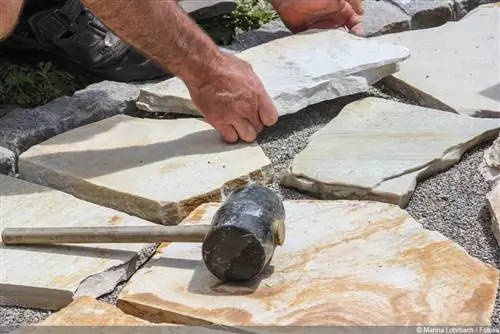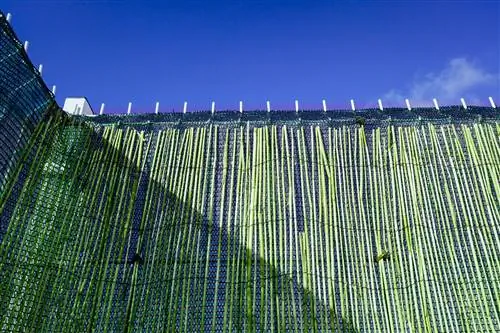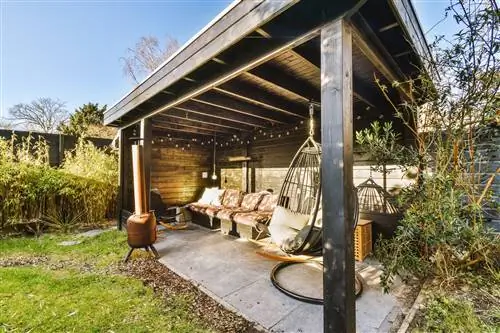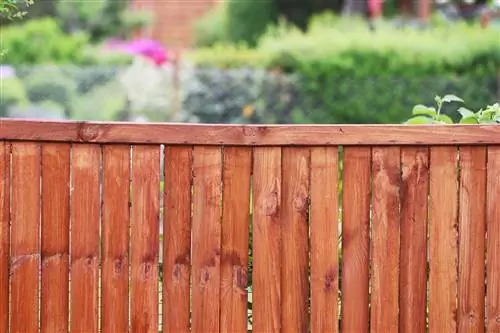- Author admin [email protected].
- Public 2023-12-17 03:39.
- Last modified 2025-06-01 06:48.
Sunbathing, reading an exciting book in peace or having a conversation without interruption with a good friend or partner - anyone who lives in a semi-detached house or a terraced house does not enjoy any privacy, at least on the terrace. Eventually the neighbors overhear. A patio partition not only creates a spatial distance, but also protects you from prying eyes. With the right solution you can also reduce the background noise.
Legal regulations
But before you grab the trowel, you can't just build a soundproof wall between two halves of the house. The Neighborhood Rights Act (NachbG) regulates what type of terrace partition is built, how high it can be and who contributes to it and to what extent. Many federal states - with the exception of Mecklenburg-Western Pomerania, Saxony, Hamburg, Bremen, Bavaria and Baden-Württemberg - have their own version in which the respective regulations for enclosures are regulated. Furthermore, each municipality and city has its own regulations for certain residential communities, which can be found in the municipal statutes or the applicable fencing statutes. Further information can also be found at your local building regulations office.
Local solutions are crucial
Ultimately, however, the local conditions are decisive for the choice of patio partition wall. If stone walls are common in your area, you will have to accept them if your neighbor wants them - even if other neighbors have built a wooden fence. This regulation is particularly important if you and your neighbor cannot agree on the type and shape of a patio partition. According to the applicable rules, this should be located directly on the property boundary or should cut the respective properties equally.
8 practical and beautiful ideas for patio partitions
You can get privacy protection elements that conform to standards and comply with the law at any hardware store. These components simply need to be hung between two existing posts or otherwise secured. As a rule, it is recommended to anchor these partition walls with a concrete foundation due to their better stability. On the other hand, if you are looking for an individual solution, you need ideas that are both beautiful and practical - after all, your neighbor should be able to live with the result. One of the following eight tried-and-tested terrace partitions for semi-detached and terraced houses can be used.
Green solution: hedges made of evergreen or flowering plants
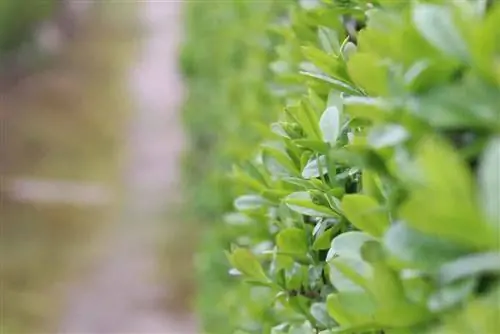
Ecological and opaque are “living enclosures” that are even stipulated in the building regulations in some communities. These are hedges that you can design in very different ways. Evergreen trees such as thuja, box or arborvitae are suitable for year-round demarcation. If you want to enjoy lush blooms, choose flowering bushes or tall perennials. Wild roses, forsythia, pipe bush, blood currant, weigela, deutzia, ranunculus bush (Kerrie), kolkwitzia, rock pear or magnificent spar are well suited for hedges.
Advantages:
- provides food and habitat for birds and insects
- Privacy protection
- Flowers / green foliage all year round
Disadvantages:
- labor-intensive: needs to be maintained and trimmed regularly
- possibly dirt from falling leaves and flowers
- attract insects - be careful if you are allergic to wasps or bees
- difficult to remove
- no soundproofing
Original: Raised bed planted with tall perennials as a border
If you would like to have a green boundary from your neighbors, but no space for a hedge, this solution is ideal: simply set up one or more raised beds and plant them with tall shrubs or perennials. The same plants can be used here as for a hedge, but also plants that are much shorter, such as many summer-flowering perennials. The height of the raised bed box also allows delphiniums, lavender and other perennial plants to be at sufficient height for privacy. Trellises or similar can also be integrated into the raised bed, which you can plant with climbing roses, clematis or other climbing plants. These provide privacy while you place lower shrubs in the foreground. Bushy fruit trees are also very suitable.
Advantages:
- colorful privacy screen
- ecological, provides food and habitat for birds and insects
- Gardening on a small area
- Raised beds can be planted differently every year
- easy to remove or implement
Disadvantages:
- labor-intensive, a raised bed requires a lot of care
- possibly dirt from falling leaves and flowers
- attract insects - be careful if you are allergic to wasps or bees
- no soundproofing
Especially green: trellis or pergola as a partition

However, you can set up and plant a trellis or pergola as a partition without a raised bed. The advantage of this variant is that it takes up less space and requires less work. Climbing roses are very suitable for climbing, but also clematis, hardy kiwi, knotweed, evergreen honeysuckle, wild vine, firethorn, climbing hydrangea or ivy. The scaffolding is available in wood and stainless steel, with the metal versions being significantly more durable. In terms of advantages and disadvantages, the same points apply here as with hedges or planted raised beds.
Tip:
Many popular garden and climbing plants (such as ivy) are poisonous and should therefore not be planted near the terrace - small children, but also cats or dogs, can taste them and become poisoned. This warning particularly applies to poisonous plants with berries (such as the popular but highly poisonous cherry laurel!).
Simple and inexpensive: wooden wicker fence
A wooden wicker fence, on the other hand, requires little effort and you can't just buy it ready-made at the hardware store. You can also build such a fence yourself using flexible willow or hazelnut rods about two meters long and sturdy wooden posts (for which you can also use branches about the thickness of your arm). To do this, drive the wooden posts into the ground at an even distance from each other. You can also encase them in concrete for better stability. Weave the branches around these posts and attach the ends to the trunks with nails or long wood screws.
Advantages:
- natural look
- Can be easily planted (e.g. with creepers or climbing plants)
- good privacy protection
- individual in height and length (if self-built)
Disadvantages:
- Very labor-intensive to set up (if you built it yourself)
- no soundproofing
- Wood rots very quickly when it comes into contact with moisture and soil
Diverse to original: wooden privacy fence
However, you don't necessarily have to intertwine wooden branches to create beautiful patio partitions. Wood is a very versatile material that can be used to create different shapes. You can also create walls out of boards or drive a row of thick planks vertically into the ground. Decorative elements such as hanging plants, lanterns or decorative figures placed on integrated ledges provide an individual touch.
Tip:
To increase the durability of such a partition, it is best to use hardwoods or durable softwoods such as larch or Douglas fir. On the other hand, spruce, poplar or birch are less suitable (as they rot quickly).
Modern and elegant: patio partition made of glass and metal
To match modern architecture, you can also create patio partitions made of metal and glass, although these cannot function as a privacy or sound barrier - unless you plant the metal fences with climbing plants or taller perennials or bushes.
Perfect privacy protection: rod mesh fence or gabion fence
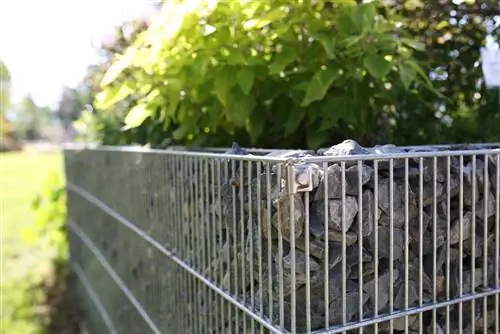
The problem of a lack of visibility and sound insulation can also be solved with a rod mat or gabion fence. Rod mats are thin metal fences of which you install two rows at the desired distance from each other and fill the resulting gap with small materials. Organic materials (tree bark, coconut shells) as well as inorganic ones (pebbles, gravel) are suitable for this, although organic materials naturally rot after a while and have to be replenished. Gabions, on the other hand, are stable wire baskets that can be set up and filled in different ways.
Advantages:
- narrow solution for narrow gardens/patios
- Advantages of a wall without having to build a wall
- perfect for modern architectural styles
- built quickly and easily
- good privacy protection
- very stable and robust
Disadvantages:
- insufficient sound insulation
- concrete foundation necessary depending on the height of the “wall”
For more privacy: brick patio partition
The only way to achieve a certain level of sound or noise protection through a partition is a wall. You can build these either from shaped stone, concrete, brick or natural stone. Build in dry construction. However, when it comes to dry stacked walls, please remember that for static reasons they should not be higher than around 60 to 80 centimeters. But even a mortared wall should be at least 30 centimeters thick with a height of around 1.80 meters - and have a solid foundation. The statics are extremely important, especially near the terrace and when children are playing, so that the structure does not simply fall over one day.
Advantages:
- very good privacy protection
- Good sound insulation depending on the construction and material used
- versatile and individually designed
Disadvantages:
- Consider statics
- Pay attention to shadows
- requires a lot of space
- high work and material costs


